new posts in all blogs
Viewing: Blog Posts Tagged with: 2012, Most Recent at Top [Help]
Results 51 - 75 of 303
How to use this Page
You are viewing the most recent posts tagged with the words: 2012 in the JacketFlap blog reader. What is a tag? Think of a tag as a keyword or category label. Tags can both help you find posts on JacketFlap.com as well as provide an easy way for you to "remember" and classify posts for later recall. Try adding a tag yourself by clicking "Add a tag" below a post's header. Scroll down through the list of Recent Posts in the left column and click on a post title that sounds interesting. You can view all posts from a specific blog by clicking the Blog name in the right column, or you can click a 'More Posts from this Blog' link in any individual post.
For the first time, I read a
Louise Rennison book that I felt was pretty much like the one I read before. I suspect her
Georgia Nicholson books are a lot alike, but I happened to read them far enough apart that I didn't care. With
A Midsummer Tights Dream, I felt that it really was pretty much
Withering Tights.
Of course, that's not going to be a bad thing for many young readers.
I still think these Tallulah Casey books have a little more depth than the Georgia Nicholson books. There's the parody of artistic types, for one thing. It's the same parody from the first book, but, still, good stuff. Plus there is the casual acceptance that young people read classics and make jokes with literary references. (Yeah. Maybe in England.) And, by the end of the book, I was feeling a little compassion for poor Lulahloo's experiences with good boys and bad. There is a sort of mystery of life that she's trying to solve, pretty much by herself.
Here's something I found to be a hoot. I've been reading
How to Be a Woman by
Caitlin Moran, and while reading
A Midsummer Tights Dream, I thought, Why, with all her talk of corkers and snogging (though while not necessarily using those words) Caitlin Moran sounds for all the world like a Louise Rennison protagonist. Louise Rennison may have created Caitlin Moran.

By:
Becky Laney,
on 3/9/2013
Blog:
Becky's Book Reviews
(
Login to Add to MyJacketFlap)
JacketFlap tags:
YA Fiction,
YA Fantasy,
J Fiction,
J Fantasy,
Scholastic,
2012,
YA Adventure,
J Adventure,
review copy,
books reviewed in 2013,
Add a tag
The False Prince. Jennifer A. Nielsen. 2012. Scholastic. 342 pages.
I thought this one would be good, but even I didn't expect it to be THAT GOOD. This book is WONDERFUL. Everything I wanted it to be! Readers first meet an orphan named Sage. When we meet him, he's on the run having just stolen meat from the butcher. He is "rescued" from the butcher by someone in the crowd, Connor. But is the rescue genuine?
Connor goes with Sage to the orphanage and explains that he's just bought Sage. Sage soon meets other orphan boys his own age that Connor has bought from various orphanages in the land. He's taking them to his castle...
Sage is suspicious fearing that Connor and the men working for him are DANGEROUS. Yes, he could be beaten, he could be imprisoned, but he knows that he could also be KILLED if he displeases Connor. Does knowing this make Sage less defiant or outspoken? Not really.
Connor has a plan--an ambitious plan. The royal family has been killed, murdered, and no one knows the truth, yet. The second son was presumed dead at sea, but, what if one of the orphan boys could assume this second son's identity and become king? Connor wants the boys in competition with one another and in training to become the future king. In a few weeks time, he'll pick the "lucky" boy.
Sage wants to be the boy, for better or worse, perhaps knowing that to fail in this means certain death. But that doesn't mean he likes Connor or trusts him. He doesn't trust Connor...at all.
I loved spending time with Sage! I loved being introduced to this fantasy world!!! I loved the setting, the characterization, the writing!!! This is a magical, oh-so-satisfying read!
Favorite quote:
“The saddest thing is there won’t be anyone to miss us when we’re gone. No family, no friends, no one waiting at home.”
“It’s better that way,” I said. “It’ll be easier for me, knowing my death doesn’t add to anyone’s pain.”
“If you can’t give anyone pain, then you can’t give them joy either.”
Read The False Prince
- If you like fantasy, especially MG or YA fantasy
- If you love fantasy, this is a MUST read
- If you like fantasy novels with great world-building and characterization
© 2013 Becky Laney of
Becky's Book Reviews
When you're not changing points of view, you're just changing bodies. That's what's happening in
David Levithan's pretty fine book
Every Day. A, the mysterious protagonist who doesn't know who or even what he is, wakes up every morning in a new body and has to live that person's life for him or her for the next twenty-four hours. So though every chapter is the story of A being a new person and dealing with that new life, he is always A. We're not really getting a point of view switch at all.
I'm still reading
Wired for Story by Lisa Cron. One of the points that author makes is that humans are drawn to story because we evolved using it to help us survive, to help us determine and plan what we should do in various situations. Nowadays when reading fiction, the protagonists are stand ins for us, trying out different scenarios so we don't have to.
If that is the case,
Every Day is a treat for the brain, giving readers an opportunity to try out a large number of situations--being diabetic, beautiful, gay, depressed, obese, nasty, and kind, just for starters.
The New York Time's
review of the book made a big point about
Every Day being a love story. Now that that's been pointed out to me, I guess it is. But A's basic situation and humanity are so engrossing that I didn't give that aspect of the book much thought.
A appears to be aging along with the bodies he inhabits, meaning that at some point he always woke up in a five-year-old's body and then a six-year-old's and now he's in his teens. I believe he's supposed to be in tenth or eleventh grade. I do feel he is a little too mature sometimes, a little too much like the only adult in the room.
But over all, the basic story is marvelous and the book is beautifully written. I had heard some talk of it last year, but I'm surprised I didn't hear more. I know it's been nominated for the
Andre Norton Award for Young Adult Science Fiction and Fantasy.

By:
Becky Laney,
on 1/24/2013
Blog:
Becky's Book Reviews
(
Login to Add to MyJacketFlap)
JacketFlap tags:
books reviewed in 2013,
biography,
picture books,
Nonfiction,
2012,
j nonfiction,
Houghton Mifflin Harcourt,
review copy,
2013,
Add a tag
Miss Moore Thought Otherwise: How Anne Carroll Moore Created Libraries for Children. Jan Pinborough. Illustrated by Debby Atwell. 2013. [March 2013] Houghton Mifflin Harcourt. 40 pages.Once in a big house in Limerick, Maine, there lived a little girl named Annie Carroll Moore. She had large gray eyes, seven older brothers, and ideas of her own. In the 1870s many people thought a girl should stay inside and do quiet things such as sewing and embroidery. But Annie thought otherwise...There was a time when children weren't allowed in libraries, weren't allowed to touch books let alone to take them home. Some librarians felt differently. Anne Carroll Moore was among them. Children needed access to books, to good children's books. Libraries needed to have special rooms and collections for children. Miss Moore Thought Otherwise tells the story of one librarian whose special work within the field of librarianship had a great impact on the world, on how people thought of libraries. The book does note that she was not the only librarian working in this field, striving to make children's rooms a part of every public library. She just happened to be in the right place and right time. (New York City). She not only was a librarian; she reviewed children's books and compiled recommended reading lists as well.
I definitely enjoyed this one. It is so easy to take having access to books for granted, it's good to have a reminder now and then that it always wasn't so. This book might pair well with
Miss Dorothy's Bookmobile.
Noah Webster & His Words. Jeri Chase Ferris. Illustrated by Vincent X. Kirsch. 2012. Houghton Mifflin Harcourt. 32 pages.
Noah Webster always knew he was right, and he never got tired of saying so (even if, sometimes, he wasn't). He was, he said, "full of confidence" [noun: belief that one is right] from the beginning. He was born in 1758 on a farm in West Hartford, Connecticut, when America still belonged to England, and by the time he was twelve he knew how to grow everything from beans and corn to peas and potatoes. His father said Noah would be a fine farmer, following in the footsteps of a long line of Webster farmers. But Noah did not want to be in that long line. He didn't want to be a farmer at all. I definitely enjoyed this picture book biography of Noah Webster. The narrative was straightforward and yet playful at times with it's interruptions of definitions. The book provides background on American life and culture in addition to providing background on Webster himself. The book primarily focuses on Webster writing AMERICAN textbooks for use in schools and his writing of the AMERICAN dictionary. There are plenty of details to bring this story to life. For example, his blue-back speller cost fourteen cents, but Webster's profit was only a penny per book sold. It didn't take Webster long to learn that he wouldn't be getting rich by writing textbooks. Half the book focuses on the time he spent working on the dictionary. It was quite an accomplishment of course...
An example of the book's playfulness:
Now Noah needed to read the two thousand pages he had worked on for almost twenty years, to be sure there were no mistakes. Next, he needed to find just the right publisher. Last, he needed to take a nap.
I would recommend this one.
© 2013 Becky Laney of
Becky's Book Reviews
The Giant and How He Humbugged America. Jim Murphy. 2012. Scholastic. 112 pages.
The Giant may not be Jim Murphy's best work of nonfiction, it is still a mostly interesting account of an American hoax in the nineteenth century. The opening chapters tell an unfolding story of the discovering of the petrified giant and its immediate local success. The first fifty pages or so stay in the moment, the rest of the book, on the other hand, chronicles the hoax from beginning to end revealing the intent, showing how it was carried out, detailing all the people involved, following the story from its local beginning all the way around its tour. It does provide a behind-the-scenes look at supposedly "clever" deceivers, and the supposedly gullible audience that "should" have known better. I didn't particularly like learning about these (slimy) characters. But the story revealed wasn't uninteresting. But there were parts of the narration I just didn't care for. (I am not sure it was the author's intent to be condescending in matters of faith, but it didn't feel right to me either.)
Read The Giant And How He Humbugged America
- If you like nonfiction for tweens and/or teens
- If you like Jim Murphy
© 2013 Becky Laney of
Becky's Book Reviews
 |
| New Year's Eve fireworks, 2012; photo by Matthew Cheney |
I have a small contribution in the grand collage that is the Strange Horizons reviewers'
"2012 in Review". Well worth taking a look at for the huge, wonderful variety of writers' interests and enthusiasms.
Happy new year!
Sidney Chambers and the Shadow of Death. James Runcie. 2012. Bloomsbury. 400 pages. (Grantchester Mysteries Series #1)
Canon Sidney Chambers stars in six cozy-mystery novellas set in Britain around 1953-1954. There are six mysteries to be solved; some mysteries include a dead body, others do not: in some it's a case of jewelry theft or kidnapping. Though there are six separate mysteries to be solved, there are a handful of characters whose lives we follow from story to story. Readers get to know the people closest to Chambers, and we also get to see into his personal life. There are two women that intrigue him: the first the widow woman introduced in the first story; the second is a glamorous, sparkly woman introduced in the second story. Amanda, the second woman, gives Sidney a Labrador--a dog he names Dickens.
For readers who enjoy cozy mysteries, cozy historical novels with plenty of detail and well-drawn characters, Sidney Chambers and The Shadow of Death is well worth considering. I didn't love all six stories. But I can easily say that I LOVED about three or four of them. The stories are all different from one another. It was easy to love Sidney Chambers.
My favorite stories were "The Shadow of Death," "A Question of Trust," and "A Matter of Time."
"The Shadow of Death"
Canon Sidney Chambers had never intended to become a detective. Indeed, it came about quite by chance, after a funeral, when a handsome woman of indeterminate age voiced her suspicion that the recent death of a Cambridge solicitor was not suicide, as had been widely reported, but murder. (1)
"A Question of Trust"
It was the afternoon of Thursday 31 December 1953, and a light snow that refused to settle drifted across the towns and fields of Hertfordshire. Sidney was tired, but contented, after the exertions of Christmas and was on the train to London. He had seen the festival season through with a careful balance of geniality and theology and he was looking forward to a few days off with his family and friends. (82)
"First, Do No Harm"
One of the clerical undertakings that Sidney least enjoyed was the abstinence of Lent. The rejection of alcohol between Ash Wednesday and Easter Sunday had always been a tradition among the clergy of Cambridge but Sidney noticed that it neither improved their spirituality nor their patience. In fact, it made some of them positively murderous. (148)
"A Matter of Time"
It was the seventh of May 1954 and Sidney had, at last, perfected the art of boiling an egg. (218)
"The Lost Holbein"
Locket Hall, with its grand E-shaped exterior of Ham Hill stone and mullioned windows, had been built at the beginning of the sixteenth century and was one of the finest stately homes in the vicinity of Cambridge. (282)
"Honorable Men"
Sidney was talking to himself again. 'Vanity, vanity, all is vanity, saith the Preacher,' he muttered as he walked towards the Arts Theatre for the first rehearsal of a modern-dress production of Shakespeare's Julius Caesar. (331)
The second novel in the series,
Sidney Chambers and The Perils of The Night, will be released in May 2013.
Read Sidney Chambers and The Shadow of Death
- If you love mysteries
- If you love cozy mysteries
- If you love historical fiction set in Britain (1950s)
- If you enjoy character-driven novels
- If you like novellas
© 2013 Becky Laney of
Becky's Book Reviews
.jpeg?picon=3103)
By: Jenny Miller,
on 12/31/2012
Blog:
Where The Best Books Are!
(
Login to Add to MyJacketFlap)
JacketFlap tags:
Star Wars,
2012,
pop-up books,
gift guide,
books for teachers,
book ideas,
princess books,
best holiday gifts,
imported books,
magical books,
Add a tag
 |
| from the Christmas Quiet Book |
Click a link to go directly to a post!
Happy holidays, from everyone at First Book!
We had a big year here at First Book! I want to let you know everything we accomplished this year, and ask for your support as we continue our work to transform education by bringing new books to children from low-income families.
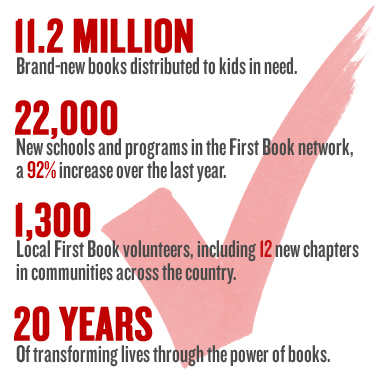 First Book celebrated two big milestones this year – our 20th anniversary and the distribution of our 100 millionth book. We also expanded the First Book network to bring brand-new books to a lot more teachers, librarians and local program leaders; 22,000 new schools and programs signed up in 2012, an increase of 92%.
First Book celebrated two big milestones this year – our 20th anniversary and the distribution of our 100 millionth book. We also expanded the First Book network to bring brand-new books to a lot more teachers, librarians and local program leaders; 22,000 new schools and programs signed up in 2012, an increase of 92%.
On top of that, we delivered 11.2 million books, started local First Book volunteer chapters in a dozen new communities, and started offering critical new categories of books that teachers tell us are badly needed: anti-bullying books, healthy living books, bilingual/non-English titles and more.
But I don’t want to overwhelm you with numbers and statistics.
What all those things mean is new, high-quality books into the hands of kids from low-income families, the books they desperately need to succeed – in school and in life.
I will share with you a comment we received recently from Sue Carnes, a librarian at Kate Bell Elementary in Houston, about working with First Book to get new books for her students this year:
“First Book is the light at the end of the tunnel, the pot of gold at the end of the rainbow. I wish you could have seen the smiles on the faces of the kids and teachers. Our students are never without a book now, even when the library is closed. Sometimes when things sound too good to be true, they are both good and true.”
Thank you so much for your support of First Book and the children who are counting on us.
Kyle Zimmer
President, First Book


By:
Valerie Walsh,
on 12/23/2012
Blog:
ValGal Art
(
Login to Add to MyJacketFlap)
JacketFlap tags:
pop-up card,
Illustration Friday,
snow,
Valerie Walsh,
Christmas Card,
paper,
Castle,
2012,
glow,
Tower,
The Artistic Adventures of Valerie Walsh,
Add a tag
My submission for Illustration Friday's "Snow and "Glow" theme is a pop-up Christmas card made of paper, paint, some photo shop and a little glue too. Have a very Merry Christmas to you!!!
.jpeg?picon=3103)
By: Jenny Miller,
on 12/21/2012
Blog:
Where The Best Books Are!
(
Login to Add to MyJacketFlap)
JacketFlap tags:
best picture books,
inspirational books for kids,
boy who flies,
seize the moment,
books about flight,
Bartholomew Biddle,
books about letting go,
imagination,
2012,
holiday gift idea,
Gary Ross,
Matthew Myers,
Add a tag
Bartholomew Biddle and the Very Big Wind, by Gary Ross, illustrated by Matthew Myers,
Candlewick, $17.99, ages 6 and up, 96 pages, 2012.
A boy flies away from home to escape his ordinary life, only to discover that he misses his parents, his tasks and routines.
In this exhilarating poem by film director Gary Ross, Bartholomew Biddle straps on a bedsheet and soars out of his window at night to see what the world has to offer.
"'Why, that looks like fun! / Just look at those trees! They're bending in half -- yeah, that's quite a breeze,'" he says, as a wind blows in to carry him away.
In bare feet and pajamas, Bart paraglides out over houses and cars, and fancies himself the "World's Best Bedsheet flier."
"'Wow, this isn't bad!' / he said, swooping and soaring, / buzzing the rooftops while / people were snoring."
Bart climbs higher and "levels 'er off," then decides he's ready to go somewhere. In the next chapter, Bartholomew wakes up cradled in his sheet between limbs of a banana tree.
Looking down, he realizes he's on a tropical island and sees a band of pirates as merry as can be. In no time, they invite him down to dig up gold and feast on mango pie. It's paradise. And yet it's almost too perfect even for pirates.
One day, Bart hears crying and learns that the pirate's captain is homesick for the sea. The captain misses being surprised by life and not having things work out perfectly right: "Fun isn't fun fun / when it's all that you know."
Bart realizes he misses those things too, and tells the pirates he's "gotta be going" and sets off in search of home. "'Cause tough as it was / to admit to himself / he missed his old room / and the toys on his shelf."
"And even his mom / at a quarter to eight: 'C'mon sleepyhead -- you're one hour late!"
As Bart takes flight again, the wind ripples through his pajamas, now tattered at the cuffs like those of a pirate's slops -- reflecting the adventuring he's already done.
But wind, like life, is uncertain and as Bartholomew coasts for home, he finds himself plummeting down into more peculiar places: where people never leave because they're afraid to or they feel stuck.
Each landing comes abruptly, while Bartholomew is reflecting on things he misses back home, and is also serendipitous: while stranded in these places, Bart learns what it means to really live.
First, the wind peters out over a sad little town where men head off to work with their eyes toward the ground. While Bartholomew loses altitude, he wonders if his dad is like these men, shuffling off to work in a daze.
"Each morning and night / he'd pass through that door, / but what comes in the middle? There's got to be more..."
Then Bartholomew remembers a glistening day, when he and his dad lay on the floor with 500 shades of crayons, marveling at all of the possibilities life has to offer.
"You're young, and the future / is yours to be plucked," his dad said that day.
But then Bart clips a tree and is startled back to reality. He falls into a mucky pond by an austere-looking boarding school, where students have so many rules, they can hardly keep track.
"No running, no jumping, / no chewing of gum, / No teasing, no sneezing, / no crying for your mum."
But then Bart befriends one of the students, Densy, who longs to explore too and Bart asks him to fly away with him. Though Densy longs to do so, he's afraid to break the rules and at the last minute, chooses to stay.
Reluctantly, Bart leaves his new friend behind and soars up until Densy is just a dot on the ground. Soon, Bart is lost in a cloud that leads to a storm and then he's pitched back to the ground.
With rain pelting down and his sheet tearing, Bart plummets into a canyon where all sorts of explorers and risk-takers are stranded. Among them an aviator "Amelia", a balloonist, windsurfers, a Swiss mountaineer and pioneers.
The canyon is enclosed by sheer cliffs and everyone has assumed there's no way out. "They sit and they stare / at nothing at all," having lost the spirit of adventure that got them there.
Will Bart lose his ambition too? Or will a friend new to all this adventuring take a chance, and come and try to save him?
Ross' debut into children's writing is wondrous and though the poem is epic (for a picture book), it has an easy cadence that keeps readers bounding along to the end.
The message for children is simple and wise, and reminiscent of something Dr. Seuss would write:
Life's for living -- seize the moment, break free. But then come home -- check in, learn the things you need to know before setting off again.
I read this to my eight-year-old son and knew almost instantly we'd read straight to the end. It was his punctuated laugh and beaming face that cued me in, as he reacted to the line, "He'd turned from a ten-year-old / to a small plane."
It took almost an hour to read the book and though my voice got a little craggy, we didn't want to stop till the end. When the last page did come, we felt as if we could float off to bed.
Myers' paintings are exhilarating, particularly those of Bart in flight, and have whimsical touches that float about the page. When Bart learns how explorers blew into the canyon, Myers scatters humorous images of them between poem columns.
The edges of the pages become the walls of the cavern as characters tumble down: On one side, a tornado whirls down with a flag at the top, representing a golfer who got swept away, and below that a man falls clutching the arm of a giant clock to represent being in the right place at the "wrong time."
Not all of the pages are illustrated, but after awhile it didn't matter. By the end of the poem, I realized we'd already filled in all of the blanks with our imaginations.
This is a joyful read for any child who wishes they could lift off and fly.
Of course, we don't want children experimenting with flight. (A cautionary note appears at the beginning of the story.) But wouldn't it be great to see them in the backyard on a windy day, running around with a sheet at their backs?
Ross is the director of many acclaimed films, including The Tale of Despereaux, Pleasantville, and The Hunger Games.
Fed up with stories about how the world will end on December 21, 2012, NASA released the video embedded above: Why the World Didn’t End Yesterday.
The video provides some excellent insight into the Mayan calendar, an astrological masterpiece that scientists have studied for years. Instead of worrying about the end of the world, you should take this opportunity to learn more about the Mayan culture.
Below, we’ve linked to free eBooks about Mayans (available in all major formats) to help you learn more about this amazing culture.
continued…
New Career Opportunities Daily: The best jobs in media.

By: Brian Minter,
on 12/20/2012
Blog:
First Book
(
Login to Add to MyJacketFlap)
JacketFlap tags:
2012,
Kyle Zimmer,
Success Stories,
Volunteers,
year-end,
infographic,
#bookstokids,
books to kids!,
First Book Supporters,
Book Recipients,
First Book,
Book Distributions,
Add a tag

* Click on the graphic to see a bigger, snazzier version.
Learn more about how First Book provides new books to kids in need, and how you can get involved, at firstbook.org. 

 This is going up on December 20, 2012, so Happy New Baktún Eve! Yeah, I know a lot of folks are expecting asteroids, comets, polar shifts, flying saucers, zombies and other madness, but not me. I’ve been through this End of the World thing a few times, and I also know something about the Maya, so I’ve got a few things to say.
This is going up on December 20, 2012, so Happy New Baktún Eve! Yeah, I know a lot of folks are expecting asteroids, comets, polar shifts, flying saucers, zombies and other madness, but not me. I’ve been through this End of the World thing a few times, and I also know something about the Maya, so I’ve got a few things to say.
Back in the Nineties, I was desperadoing it on an awful temporary job. One of my co-workers had a kidney infection, the other had the Grim Reaper tattooed on each of his skeletal arms. Mr. Kidney Infection went on and on about how he was at an all-day lecture by a “Navajo shaman” who said the world was coming to an end in a couple of months, stating astronomical fantasies out of 20th century pseudoscience rather than Diné cosmology. Mr. Grim Reaper disagreed: “The Bible says the world’s gonna end in the year 2000.” I did my best to stay out of it.
Then there was the whole Y2K thing. Doesn’t anybody remember that? I wonder what happened to all those generators and gas masks people were stocking up on?
And, of course, there’s already a backlash. “If the Mayans say they could predict the end of the world, how come they didn’t see their own demise? Yuk! Yuk! Yuk!” By the way, it’s Maya, not “Mayans.” Maya are the people. Their stuff is Mayan. Talking about “Mayans” just shows that you don’t know what you’re talking about.
The culture of the Maya fell due to drought, small pox, and European invaders, but they did not die off. There are around seven million of them living in southern Mexico and Central America.
I’ve been to Mayalandia. Once you get down to the tropics, deserts give way to jungles, and the people are small and brown with faces out of Mayan art. They often speak the local Mayan dialect instead of Spanish. The names of towns and streets are heavily Mayan.
Also, there are Maya in the United States these days. People who think they are smarter than the “Mayans,” have their heads too far up their butts to recognize the Mayas cleaning toilets and mowing lawns in their towns.
 What we have here is a case of classic snake oil in postmodern New Age packaging. You didn’t hear about it until the Seventies and Eighties. Before that, the fact that the Mayan calendar ended at Baktún 13 wasn’t considered a big deal. 13 is considered a lucky number, so why not end it there? The alternative would be to keep computing the calendar forever. But the snake oil salesmen got ahold of it, and folks just seem to love hearing that the world is coming to an end.
What we have here is a case of classic snake oil in postmodern New Age packaging. You didn’t hear about it until the Seventies and Eighties. Before that, the fact that the Mayan calendar ended at Baktún 13 wasn’t considered a big deal. 13 is considered a lucky number, so why not end it there? The alternative would be to keep computing the calendar forever. But the snake oil salesmen got ahold of it, and folks just seem to love hearing that the world is coming to an end.
You don’t have be factual. You don’t have to be accurate. The popular image of the “Mayan calendar” we’re seeing all over the interwebs is really the Aztec Sunstone.
So get over it. It’s just a new baktún. 144,000 days. About 394 years. Plenty of time.
 Why aren’t we celebrating beginning of Baktún 14, or the restarting of the Long Count cycle, the Sixth Sun? What’s the matter? Don’t you want a future? Happy New Baktún, cabrónes!
Why aren’t we celebrating beginning of Baktún 14, or the restarting of the Long Count cycle, the Sixth Sun? What’s the matter? Don’t you want a future? Happy New Baktún, cabrónes!
Reading
Scarlet by
A.C. Gaughen was a fascinating experience. The book is the Robin Hood story from the point of view of Will Scarlet, one of Robin's band of so-called merry men. Except in this rendition, he's a cross-dressing young woman.
First, I was caught by the voice. Voice can be tricky in historical novels. Characters from the past shouldn't sound twenty-first century, but at the same time, making them sound
nontwenty-first centuryish can also mean making them sound contrived or stilted. And while we know how people--particularly educated people--wrote in days of old, we can never really know how they sounded. The key to Scarlet's voice is that she's very ungrammatical. She appears to be unaware of the third person singular of the verb "to be," throwing "were" in everywhere. "That were Rob's version of a greeting." "'First, Freddy Cooper were arrested,'" I said, looking around. It weren't good news." Also, she uses the word "lads" for the other band members. I like the word "lad."
So I liked Scarlet's voice right away. What I didn't like was when she said things like, "Rob looked at me, and as were fair usual, I felt my heart jump." I thought, Oh, no. A romance. Why must there always be a romance? I don't know if I'm going to be able to take this for long.
I switched between reading
Scarlet and another YA historical novel, figuring I'd stay with the one that hooked me first. As it turned out, it was
Scarlet.
Why?
Because I realized I would have loved
Scarlet when I was a teenager. I...mean...
loved it.
The girl who dresses up like a boy so she can escape the restrictions of her society and be tough and strong and do exciting things? Teenage Gail loved those characters.
The girl-who-is-torn-between-two-lovers scenario, as Scarlet is with Rob and someone who will remain nameless? As an adult, I find that a tedious cliche. As a teenager? Loved it.
The star-crossed lovers who are always misunderstanding cues and take forever to get together? As an adult, I want to slap those characters and tell them to get on with it. But teenage Gail couldn't get enough of that Elizabeth Bennett/Mr. Darcy vibe.
As I was reading this book, I felt as if I was being transported back in time. Not back into the time of the story, but back into my past. I don't think I have ever read a book that took me back to my teenage reading experience the way
Scarlet did.
Also, there is a great reveal in
Scarlet that I never saw coming but realized immediately made sense.
Plot Project: The whole Robin Hood mythology is one of those cultural things everyone seems to know about even if we can't remember why. (Maybe even more so than King Arthur, probably because Robin Hood is a much more democratic and contemporary sounding figure. He's all about redistribution of wealth, after all.) I suspect that Gaughen tweaks much of the basic Robin Hood narrative for her plot. Good story, but what is even more impressive is the situation/world she came up with to put the storyline within. There's more going on here than just making Will Scarlet a female.
Scarlet is a
Cybils nominee in the YA category.
.jpeg?picon=3103)
By: Jenny Miller,
on 12/19/2012
Blog:
Where The Best Books Are!
(
Login to Add to MyJacketFlap)
JacketFlap tags:
Hamilton,
holiday gift ideas,
2012,
Finch,
Hide and Seek,
Ferguson,
Mansfield,
Haines,
Pop-Up London,
best gifts for kids,
One Spotted Giraffe,
Maizels,
Popposites,
best pop-up books,
Wizard of Oz pop-up,
Add a tag
Book meets toy: the novelty book. Here are some of my favorites.

Pop-Up London, by Jennie Maizels, paper engineering by Richard Ferguson, Candlewick, $19.99, ages 5-9, 2012. Baroque architecture rises from the pages of this entrancing book, and tempts readers to pull in close and peak around building corners. Gorgeously rendered in pen-and-ink, each spread leads readers from one famous district of London to the next. A small booklet at the top of the scene describes what it's like to enter the district. It then explains its significance, shares secrets about it, and asks questions that readers must then search to answer on the ground and behind buildings. Diminutive flaps, hidden pictures and pop-ups turn this book into an adventure. Among the many delights: two sculls that race on the river Thames along slits, and a scene inside Buckingham Palace that shows royals gathered at a banquet and dancing. The palace's interior walls are detailed like a finely furnished doll house: a two-story scene of butlers rushing about and the king and queen waving from a balcony. Another page features a pop-up of the London Eye, which readers erect by folding back a tab.

Any child who loves cities, architecture or miniatures will be dazzled -- and, chances are, they'll soon be begging for a trip to London. This isn't just a pop-up; it's an experience. The book transports readers into the city on a scavenger hunt down the Thames, in and out of lanes and even across a 3-D Tower Bridge, the grand finale. Best parts: Every little detail. This is one of the best pop-up I've ever seen. Readers will want to lay it open on the dresser and imagine they're tiny enough to walk around the page. The only hard part will be deciding which district to display.

Popposites: The Pop-Up Opposites Book!, by Mike Haines and Keith Finch, Kingfisher, $16.99, ages 3 and up, 2012. Few books of opposites can match this one. The creators of Wild Alphabet return with a clever spin on opposites. Every page has unique tabs that when rotated or pulled transform one scene into its opposite. The authors begin by contrasting old things with new, and as readers turn a tab, an ancient pyramid rises into the sky and becomes the roof of a modern skyscraper. Every layout if unique and whimsical. On one page, readers look into an empty portal, then turn a tab and six faces slide out from the edges looking back at them. On another, readers learn about the extremes of sound: an elephant stands quietly with his trunk down, then with the pull of a tab, he raises his trunk and opens his mouth to suggest he's trumpeting. Another favorite shows a flying arrow (the past) transforming into a soaring rocket ship (the present). My only caution is that pull tabs can be stiff at first -- I found this particularly true of a zipper used to show "together" and "apart" -- so it's good for parents to loosen the tabs up a little before passing it on to a small child. Best parts: A lesson about up and down: as readers pull a tab, a dapper man climbs a staircase and a boy slides down on a railing. And a page about big and little: readers see Earth floating in a circle of stars and as they pull a tab, a hand closes around it, making our planet look suddenly tiny, which when compared to the universe, it truly is! To read my 2010 review of Wild Alphabet click here.

The Wizard of Oz: A Classic Story Pop-Up Book With Sounds, by L. Frank Baum & Paul Hess, design and paper-engineering by Andy Mansfield, retold by Libby Hamilton, Silver Dolphin, $18.95. ages 4 and up, 2012. A twister as tall as a ruler pops up from the fold and triggers blustery sounds that transport readers into the action of L. Frank Baum's classic novel. In this atmospheric remake of
The Wizard of Oz, readers see five scenes from the story rise from the page as they read an abridged narrative of the classic. When each pop-up opens, a tab slides at the fold to turn on sound effects, ranging from the cackling of flying monkeys to a crescendo of orchestral music at the gates of Oz. In the first pop-up, Toto barks frantically, a cow bellows and the wind rattles about, sucking up everything in its path. Auntie Em and Uncle Henry's farmhouse spins at the top of vortex, with a shocked Dorothy staring out the window. Opposite is a giant uprooted tree flipped upside down, while below, a tractor whirls around with a cow rising from below. Under that, they see the narrowing tail of the tornado cutting a path across a swath of checkerboard farmland. The perspective is fantastic as it gives readers the feeling they're hovering in the sky nearby. It is the most stunning of the pop-ups and is the one readers are likely to open over and over. Soon Dorothy has landed in Oz and in the next pop-up she helps grease the Tin Man back to life as readers listen to his gears creak and jaunty orchestral music. Other pop-ups show the Emerald City rising like a palace, the flying monkeys carrying Dorothy and Toto away and the great head of Oz: a colorful mask-like visage. This pop-up is far less intricate than Robert Sabuda's
The Wonderful Wizard of Oz, but that also makes it more accessible for small children. I missed not seeing a pop-up of the Wicked Witch under the house, yet I was pleased that the illustrations were playful and not scary. Overall, this is a charming way to introduce young children to a classic.
Best part: The perspective of looking down at the tornado, sensing the sheer height of it, while listening to the sounds of livestock and branches getting pitched into the air.
Watch a trailer here!
For more pop-up fun, check out these other great titles:
Hide and Seek,
by David A. Carter, Tate Publishing (Abrams), $24.95, ages 3 and up, 2012.
One Spotted Giraffe: A Counting Pop-Up Book, by Petr Horacek, Candlewick, $15.99, ages 3 and up, 2012.
Reached. Ally Condie. 2012. Penguin. 512 pages.
Reached is the third in the Matched trilogy. (The books are Matched, Crossed, and Reached.) I liked Crossed more than Matched, and I think I like Reached even more than Crossed. I can easily say that I LOVED both Crossed and Reached. The world-building continues in Reached, readers get to see more, learn more. It is narrated by Xander, Cassia, and Ky. New characters continue to be introduced as well. (Lei, Leyna, Anna, Oker, etc.) The time for the Rising has come. The big, big sign of the Rising's coming was the appearance of the plague. When Xander, a medic, sees a toddler with the plague, he knows the time has come, that the Pilot will start the rebellion quickly. He knows that everyone who is a part of the rebellion are all waiting to hear the Pilot's voice. Ky and Cassia aren't aware of the coming Plague and the danger that poses to everyone who isn't immune, but, they are both eager to see the Society brought down. So Reached is essentially a compelling novel about the breakdown of a society. The plague is supposedly "helping" the cause (the rebellion) for it is the Rising who holds enough of the Cure for the public, the Rising that can provide immunizations for those not yet sick. But the plague has a mind of its own not really caring about either side, and the mutations from the original plague mean the Rising is in big, big trouble for they have no cure yet to offer the public. And no cure means people dying, a lot of people dying as they wait for the scientists and doctors and researchers to find something--anything--to find a cure.
Reached is definitely the MOST exciting of the trilogy. I loved, loved, loved reading Xander's narrative. And I love seeing the characters through his eyes. I liked Ky's narrative too, especially at the beginning because it gave readers a way to stay in touch with Indie. And Cassia is still Cassia.
I enjoyed reading a trilogy series where my love and appreciation grew with each book. As much as I enjoyed Hunger Games, I can't say that I loved the other books in the trilogy to the same degree. Especially the last book in the trilogy. Read Reached
- If you like dystopias
- If you like YA romance
- If you like love triangles
- If you enjoy reading about epidemic diseases
© 2012 Becky Laney of
Becky's Book Reviews
Fairy Tales from the Brothers Grimm: A New English Version. Philip Pullman. 2012. Penguin. 400 pages.
Fairy Tales from the Brothers Grimm: A New English Version is a collection of fifty fairy tales. I was familiar with almost half of these, though it had probably been two decades since I last read some of them. Half of the stories were completely new to me. I probably found a few new favorites. At the conclusion of each story, Pullman shares facts, details, and opinions on the story. He tells us the type of story it is, what other tales are similar, what other cultures this type of story can be found in, what changes he made and why, what changes he would have made but didn't because he wasn't trying to write a novel, what he really thinks of each story. I found these sections to be interesting. Of course, I enjoyed the fairy tales. Some stories better than others, of course, a handful I could have done without completely. Still, I found the collection as a whole to be quite fun! The kind of book that you can read a story or two a day for several weeks of entertainment. This is NOT a book to rush through. Reading two or three fairy tales in a day is great, reading thirty a day, well, it's just TOO MUCH. You may not love, love, love each and every story in the collection. You may not find all of them to be equally worthy of your time. But. Chances are you'll find something to enjoy!
- The Frog King, or Iron Heinrich
- The Cat and the Mouse Set Up House
- The Boy Who Left Home To Find Out About the Shivers
- Faithful Johannes
- The Twelve Brothers
- Little Brother and Little Sister
- Rapunzel
- The Three Little Men in the Woods
- Hansel and Gretel
- The Three Snake Leaves
- The Fisherman and His Wife
- The Brave Little Tailor
- Cinderella
- The Riddle
- The Mouse, the Bird, and the Sausage
- Little Red Riding Hood
- The Musicians of Bremen
- The Singing Bone
- The Devil with Three Golden Hairs
- The Girl with No Hands
- The Elves
- The Robber Bridegroom
- Godfather Death
- The Juniper Tree
- Briar Rose [Sleeping Beauty]
- Snow White
- Rumpelstiltskin
- The Golden Bird
- Farmerkin
- Thousandfurs
- Jorinda and Joringel
- Six Who Made Their Way in the World
- Gambling Hans
- The Singing, Springing Lark
- The Goose Girl
- Bearskin
- The Two Traveling Companions
- Hans-my-Hedgehog
- The Little Shroud
- The Stolen Pennies
- The Donkey Cabbage
- One Eye, Two Eyes, and Three Eyes
- The Shoes That Were Danced to Pieces [Twelve Dancing Princesses]
- Iron Hans
- Mount Simeli
- Lazy Heinz
- Strong Hans
- The Moon
- The Goose Girl at the Spring
- The Nixie of the Millpond
© 2012 Becky Laney of
Becky's Book Reviews
.jpeg?picon=3103)
By: Jenny Miller,
on 12/17/2012
Blog:
Where The Best Books Are!
(
Login to Add to MyJacketFlap)
JacketFlap tags:
Judy Barrett,
Santa's childhood,
Santa from Cincinnati,
books about Santa,
Santa Claus,
Kevin Hawkes,
2012,
toymaker,
best christmas books,
Add a tag
Santa from Cincinnati, by Judi Barrett, pictures by Kevin Hawkes,
Atheneum, $16.99, ages 4-8, 48 pages, 2012.
With that big belly that shakes like jelly, it's hard to believe Santa was ever a tyke. But indeed he was -- just ask Judy Barrett and Kevin Hawkes.
The book-making dynamos come together for the first time to share the wonder years of dear old Claus -- and wondrous they were.
Even as a newborn, Santa had cheeks like roses and a nose like a cherry. As other babies wailed their way into the world, he turned his mouth up like a bow.
As you might guess, Santa was crazy for toys and the funny thing is, his stuffed toy reindeer had a habit of floating when Mom wasn't looking. Santa would take those eight toys everywhere (Mom gave him a pillowcase to carry them over his shoulder).
Santa was quirky, just like his dad. (At age 5, he glued cotton balls to his face so he had Dad's beard.) His dad was a basement toymaker and he invented all of Santa's toys. Soon, Santa was drilling alongside Dad and neighbor kids were putting in orders.
But of course all of this toy making takes time -- 365 days of time. So how does a guy with homework, prom, college and a girlfriend find the time to become the world's nicest guy?
Barrett's writing is playful and fun -- Santa's an Ohio native, so he's got a Midwest work ethic, and being a preoccupied with inventing, he's surrounded by clutter. He also has to streamline his work (by cutting naughty kids from his list).
Hawke's paintings radiate happiness. His somewhat retro style is matched with whimsical detail. One of my favorite images is on the cover (a young Santa with the shadow of his future self looming behind him).
This is a sweet picture book to feed that magical feeling of Christmas -- and remind children that life is good and that wondrous things do happen.
Best Part: Hawke gives Santa an "Elf on the Shelf" grin -- a joyful smile that never goes away.
Growing Up Humming. Mike Spinak (text and photographs). 2012. CreateSpace. 46 pages.
Growing Up Humming chronicles the time the two Anna's hummingbirds chicks spend in the nest. Readers meet the mother hummingbird, Big Sister, and Little Sister. (Big Sister is two days older than Little Sister.) Through text and photographs, readers can learn more about the baby chicks leading up to the oh-so-important day when they're ready to leave the nest and fly. (Big Sister is ready to leave the nest much sooner than Little Sister who is a bit reluctant.) There are over thirty pages of photographs, and these are quite fascinating showing off these birds in great detail. The text explains what daily life is like for these chicks, what changes they are undergoing day by day, etc. I enjoyed both the text and the photographs. I thought the book was very informative.
This nonfiction picture book would be great for little nature lovers or little bird lovers. The photographs and text complement each other nicely. The narrative flows as easily as a story, but, it has plenty of information as well.
Read Growing Up Humming
If you are interested in birds and baby chicks
If you are looking for nonfiction picture books to share with your child
© 2012 Becky Laney of
Becky's Book Reviews
I have "known"
Melissa Wiley of
Here in the Bonny Glen for years. She's written
five books, three of which came out this year.
Fox and Crow Are Not Friends is the first that I've read.
This clever
Step into Reading book uses three tidy chapters to show Fox and Crow interacting in nonfriendly ways. At the same time, the book is a complete story with a climax and surprise reveal. The images don't just illustrate text but really do carry part of the storyline. The reveal makes sense in terms of the illustration. At the end of the story, we suddenly ask ourselves, Ah, yes. Where did the cheese come from?
And this little volume is full of literary references, starting with its title.
Fox and Crow Are Not Friends calls to mind
Frog and Toad Are Friends the first of the
Frog and Toad I Can Read books by
Arnold Lobel. I once saw this series referred to as the best
I Can Read books ever written. The chapter title
A Good Smell Is Hard to Find has to make adult readers think of Flannery O'Connor's
A Good Man Is Hard to Find, a short story I've never understood. Another chapter title,
Revenge Is a Dish Best Served with Cheese is a play on "revenge is a dish best served cold,"
which is not a Klingon proverb, people! And the reveal at the end, which I don't want to give away--did it not make anyone else think of the
Berenstain Bears?
I hope we'll see more Fox and Crow books in the future.
Fox and Crow Are Not Friends is a Cybils nominee in the
Easy Readers/Early Chapter Books category.
This is Not My Hat. Jon Klassen. 2012. Candlewick. 40 pages.This hat is not mine. I just stole it. I stole it from a big fish. He was asleep when I did it. And he probably won't wake up for a long time. And even if he does wake up, he probably won't notice that it's gone. I think I enjoyed
This is Not My Hat even more than Jon Klassen's I Want My Hat Back. In this adventure, a little fish steals a little hat from a BIG fish. Since the big fish was asleep, this little fish is quite confident that the big fish will never, ever know who took his hat. The little fish thinks he's safe...probably. This one is told from his point of view, the illustrations let the reader know more than the little fish. Much more than the little fish! I think this one is quite clever.
Because Amelia Smiled. David Ezra Stein. 2012. Candlewick. 40 pages.Because Amelia smiled, coming down the street...Mrs. Higgins smiled, too.She thought of her grandson, Lionel, in Mexico and baked some cookies to send to him. Because Mrs. Higgins baked cookies...Lionel ate one of the cookies. He decided to share the rest with his class...and teach them an English song about cookies. Because Lionel taught his class a song...A little smile, a little kindness can go a long way. In fact, it may even travel around the whole world. Because a little girl, Amelia, smiled, she brought happiness and cheer to many, many people--almost all of them strangers. Little acts of kindness do matter. And you're never too small to make a difference. It is a sweet, inspirational story. I definitely enjoyed it.
Sky Color. Peter H. Reynolds. 2012. Candlewick. 32 pages.Marisol was an artist. She loved to draw and paint, and she even had her very own art gallery. Not all her art hung in a gallery. Much of it she shared with the world. Marisol is so excited to be painting part of a mural. She's volunteered to paint the sky. But when she realizes there isn't any blue paint to be found, well, she's not sure HOW she'll paint the sky after all. But a bus trip home, an evening watching the sun set, and a rainy morning inspire her to think differently and realize that many, many colors that could rightfully be called sky color! Peter H. Reynolds has written a handful of art-friendly picture books in addition to Sky Color. These include ISH and THE DOT. All three have been newly packaged together to form a "
creatrilogy."
Day by Day. Susan Gal. 2012. Random House. 40 pages.
Mile by mile, pigs motor west. Brick by brick, pigs build a house...and piece by piece, it becomes a home.Neighbor by neighbor, pigs say, "Welcome!"Arm in arm, new friendships begin.Then row by row, pigs plant a garden.I really enjoyed Susan Gal's Day by Day. Readers follow a pig family as they move west, build a home, become part of a new community; a hard-working family that at last takes time to celebrate all together with food, dancing, family...and mud. I just love the illustrations! There are so many great spreads in this one, but I think my favorite is the pigs in their underclothes!!!
Unspoken. Henry Cole. 2012. Scholastic. 40 pages.Unspoken is a wordless picture book for older readers. It is historical fiction, a story about the underground railroad. The heroine of this story is a young girl who sees someone hiding--a runaway slave--what she does next, silently, carefully--communicates everything that needs to be said. It is so difficult to review a wordless picture book, because the whole story is conveyed by illustrations and it is all left to be interpreted by the reader. But I think this one is worth reading even if you don't usually read picture books.
© 2012 Becky Laney of
Becky's Book Reviews
.jpeg?picon=3103)
By: Jenny Miller,
on 12/14/2012
Blog:
Where The Best Books Are!
(
Login to Add to MyJacketFlap)
JacketFlap tags:
imagination,
Children's Laureate,
2012,
the paper dolls,
julia donaldson,
best picture books,
books about toys,
overseas books,
playing adventures,
Add a tag
Ever wonder what clever, new books are springing up overseas? Here's a picture book I can't wait for.
The Paper Dolls, by Julia Donaldson,
Pan Macmillan, 32 pages, 2012. A little girl takes her paper dolls on a fantastical adventure through the house and into the garden. First they escape the clutches of a toy dinosaur, then an oven-glove crocodile and finally a real pair of scissors. A charming picture book by
UK's Children's Laureate and debut illustrator Rebecca Cobb. Donaldson is the author of the wildly popular
The Gruffalo and my all-time favorite
Room on a Broom.
December 13th seems like the perfect day to expand my usual Thursday Three to Thirteen. Plus I have a lot of great books to cover. At the library, I bring the best picture books back to my desk to read and share. When I don't want to give it back is when I know I have a special title. These are some of the books I could barely part with over the past year.
Another Brother
by Matthew Cordell
 The opening sets it up perfectly “For four glorious years, Davy had Mom and Dad all to himself.” Page turn. “But things change…” The first brother is annoying and disgusting – crying, spitting up, and needing to go potty. (All of that nicely illustrated, by the way.) But one new baby isn't enough for this story. No! He gets twelve brothers who follow him and copy him all the time... until they don’t. Davy’s not sure he likes being alone – but he isn’t for long. The pen, ink and watercolor illustrations complement the light, fun tone of book and this fresh take on the common sibling theme is done with humor and heart.
The opening sets it up perfectly “For four glorious years, Davy had Mom and Dad all to himself.” Page turn. “But things change…” The first brother is annoying and disgusting – crying, spitting up, and needing to go potty. (All of that nicely illustrated, by the way.) But one new baby isn't enough for this story. No! He gets twelve brothers who follow him and copy him all the time... until they don’t. Davy’s not sure he likes being alone – but he isn’t for long. The pen, ink and watercolor illustrations complement the light, fun tone of book and this fresh take on the common sibling theme is done with humor and heart.
Chloe and the Lion
by Mac Barnett and Adam Rex
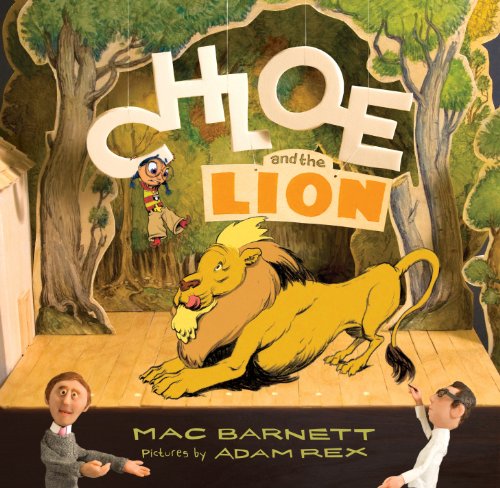 Bringing us into the book is the author, Mac, who introduces the illustrator, Adam, and our main character, Chloe. As the story moves on, she gets lost in a forest and instead of meeting up with a lion, the illustrator chooses a dragon. Author and Illustrator break into the story to argue and Adam plays tricks with his illustrator's power, leading to the hiring of a new illustrator who can't draw the way Mac wants - though he does get the lion to swallow Adam - forcing Mac to fire him and take over the artwork too, but he can't draw. The character, Chloe, stages an intervention getting the author and illustrator to make up and get things going so that the lion coughs up Adam and the story can finish up. Such a hard book to describe - complex, funny, clever, multi-layered, meta. I absolutely loved it. Great book trailer too!.
Bringing us into the book is the author, Mac, who introduces the illustrator, Adam, and our main character, Chloe. As the story moves on, she gets lost in a forest and instead of meeting up with a lion, the illustrator chooses a dragon. Author and Illustrator break into the story to argue and Adam plays tricks with his illustrator's power, leading to the hiring of a new illustrator who can't draw the way Mac wants - though he does get the lion to swallow Adam - forcing Mac to fire him and take over the artwork too, but he can't draw. The character, Chloe, stages an intervention getting the author and illustrator to make up and get things going so that the lion coughs up Adam and the story can finish up. Such a hard book to describe - complex, funny, clever, multi-layered, meta. I absolutely loved it. Great book trailer too!.
Each Kindness
by Jacqueline Woodson, illustrated by E.B. Lewis
 A new girl comes into the classroom, and she is quiet and obviously poor. Our main character doesn't let Maya play with them and even turns from her shy smiles. The kids laugh about her behind her back, even as Maya keeps trying to connect with sharing her small toys. A lesson from the teacher on kindness may be too late for this child, but makes it more poignant for protagonist and the reader. Lovely, heartbreaking story is perfectly matched with the luscious artwork which adds its own emotional component. A book you won't soon forget.
A new girl comes into the classroom, and she is quiet and obviously poor. Our main character doesn't let Maya play with them and even turns from her shy smiles. The kids laugh about her behind her back, even as Maya keeps trying to connect with sharing her small toys. A lesson from the teacher on kindness may be too late for this child, but makes it more poignant for protagonist and the reader. Lovely, heartbreaking story is perfectly matched with the luscious artwork which adds its own emotional component. A book you won't soon forget.
Extra Yarn
by Mac Barnett, illustrated by Jon Klassen
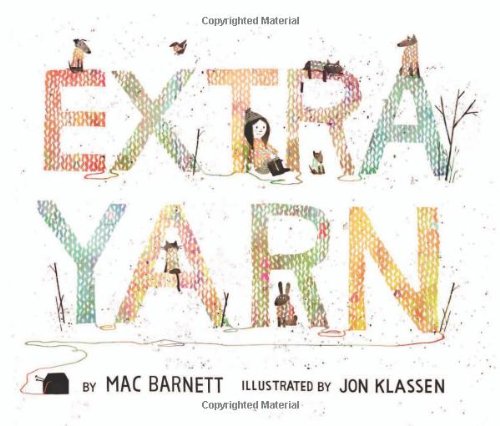 A girl finds a box filled with yarn, so she knits a sweater. Finding that she has extra yarn, she knits one for her dog too. But as there continues to be yarn she knits for all her classmates, townsfolk, animals – nice Klassen nod to the bear and rabbit from I Want My Hat Back – and even houses. Her knitting creates a colorful world that attracts the attention of an archduke who wants the box for himself. It all seems to go wrong for the little girl, but good wins out. So much to love in the book - the story that goes somewhere, the sharing of gifts freely, the play in the illustrations between grays and soft colors. A wonderful book that is getting a fair amount of Caldecott buzz.
A girl finds a box filled with yarn, so she knits a sweater. Finding that she has extra yarn, she knits one for her dog too. But as there continues to be yarn she knits for all her classmates, townsfolk, animals – nice Klassen nod to the bear and rabbit from I Want My Hat Back – and even houses. Her knitting creates a colorful world that attracts the attention of an archduke who wants the box for himself. It all seems to go wrong for the little girl, but good wins out. So much to love in the book - the story that goes somewhere, the sharing of gifts freely, the play in the illustrations between grays and soft colors. A wonderful book that is getting a fair amount of Caldecott buzz.
Goldilocks and the Three Dinosaurs
by Mo Willems
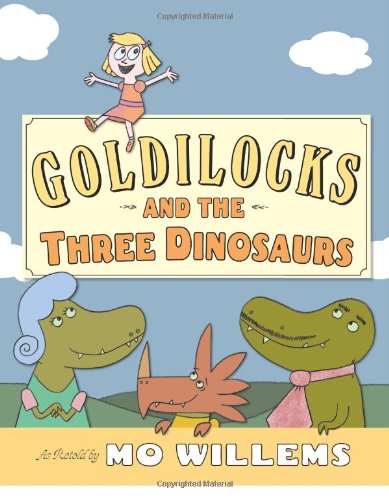 Self-referential tale of Goldilocks noting the oddly convenient bowls of food and the poorly supervised little girl among other aspects of this unexpected story. Older readers will gleefully understand that the dinosaurs are waiting for Goldilocks to come so that they can eat up a chocolate-pudding stuffed little girl. But that would make a pretty dark ending, so she gets away before things go bad. Great lines make for a perfect read aloud for early elementary kids who will get the irony. Funny and clever, this is Mo Willems having fun and inviting us along. Yes, there is a hidden pigeon or two, along with some little visual jokes for the observant reader. Excellent.
Self-referential tale of Goldilocks noting the oddly convenient bowls of food and the poorly supervised little girl among other aspects of this unexpected story. Older readers will gleefully understand that the dinosaurs are waiting for Goldilocks to come so that they can eat up a chocolate-pudding stuffed little girl. But that would make a pretty dark ending, so she gets away before things go bad. Great lines make for a perfect read aloud for early elementary kids who will get the irony. Funny and clever, this is Mo Willems having fun and inviting us along. Yes, there is a hidden pigeon or two, along with some little visual jokes for the observant reader. Excellent.
Good News Bad News
by Jeff Mack
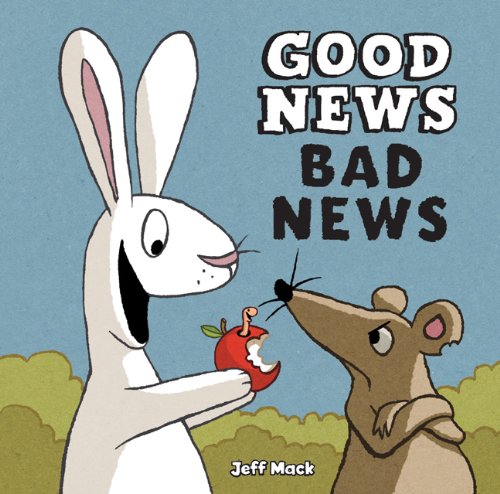 Who knew four words could say so much? As two friends prepare to have a picnic, events and their dispositions move forward a simple story of staying positive - even when being struck by lightning. Well, at least it chased off the bear! Negative mouse has the last word then which is bad Bad BAD news, finally breaking rabbit’s optimism. But friendship turns this grumpy mouse around to find good news in their friendship. Cartoon illustrations with broad strokes keep expressions front and center. Love that the mouse has a chip on his ear. Nice touch.
Who knew four words could say so much? As two friends prepare to have a picnic, events and their dispositions move forward a simple story of staying positive - even when being struck by lightning. Well, at least it chased off the bear! Negative mouse has the last word then which is bad Bad BAD news, finally breaking rabbit’s optimism. But friendship turns this grumpy mouse around to find good news in their friendship. Cartoon illustrations with broad strokes keep expressions front and center. Love that the mouse has a chip on his ear. Nice touch.
Happy
by Miles Van Hout
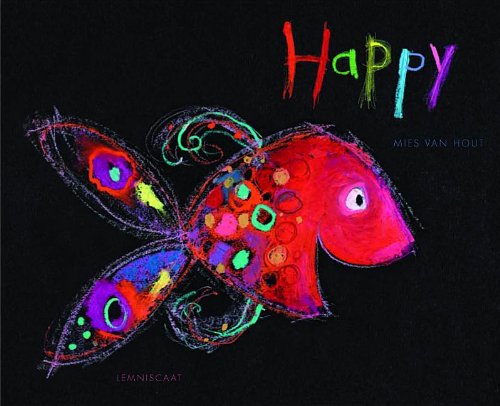 Leave it to Lemniscaat to give us another beautiful book of art that also functions as a picture book. Each whimsical, colorful fish jumps out against the black background as the opposite page describes the aquatic’s emotional state – be it curious, brave, or loving. The words are artistically rendered as well, with the background selected to accent the fish’s color while conveying a tone – red for furious, for instance. Simple in concept, the artistic execution brings this book from simplicity. Look for openings of discussion as to what makes this fish or that look proud, angry or content. Color me – like the last fish – delighted.
Leave it to Lemniscaat to give us another beautiful book of art that also functions as a picture book. Each whimsical, colorful fish jumps out against the black background as the opposite page describes the aquatic’s emotional state – be it curious, brave, or loving. The words are artistically rendered as well, with the background selected to accent the fish’s color while conveying a tone – red for furious, for instance. Simple in concept, the artistic execution brings this book from simplicity. Look for openings of discussion as to what makes this fish or that look proud, angry or content. Color me – like the last fish – delighted.
Huff and Puff
by Claudia Rueda
 With a subtitle of “Can You Blow Down the Houses of the the Three Little Pigs?” This book brings the reader into the action. The hole on the cover is echoed through the book as a peek to the page beneath as well as an invitation to the reader to be the world. Simple text, minimal illustrations in pen and ink and watercolor and an ending surprise make this a fun book for younger readers. Love the facial expressions and simplicity of statements such as, “First pig was not happy.” Your basic three little pigs have undergone a makeover, and it looks good.
With a subtitle of “Can You Blow Down the Houses of the the Three Little Pigs?” This book brings the reader into the action. The hole on the cover is echoed through the book as a peek to the page beneath as well as an invitation to the reader to be the world. Simple text, minimal illustrations in pen and ink and watercolor and an ending surprise make this a fun book for younger readers. Love the facial expressions and simplicity of statements such as, “First pig was not happy.” Your basic three little pigs have undergone a makeover, and it looks good.
Just Ducks
by Nicola Davis, illustrated by Salvatore Rubbino
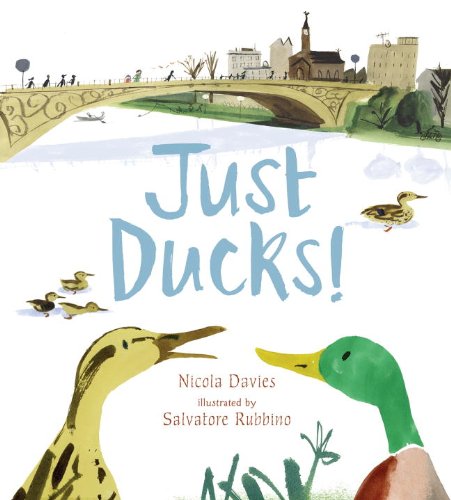 With an irregular pen-sketch style, even the font is artistic. (Cold Mountain Six, which could also be a band name.) The slight story of a girl visiting the ducks on the river is enhanced with facts about ducks, each a concise sentence. The illustrations are lovely with gentle watercolors. The colors evok the natural world with greens, browns, and grays, that pop against the white background. There are lovely details to the pictures, like the armful of toys the mom holds in the child’s bedroom or the tiny ants crawling along the grass. Simply beautiful informational book that reads like a story.
With an irregular pen-sketch style, even the font is artistic. (Cold Mountain Six, which could also be a band name.) The slight story of a girl visiting the ducks on the river is enhanced with facts about ducks, each a concise sentence. The illustrations are lovely with gentle watercolors. The colors evok the natural world with greens, browns, and grays, that pop against the white background. There are lovely details to the pictures, like the armful of toys the mom holds in the child’s bedroom or the tiny ants crawling along the grass. Simply beautiful informational book that reads like a story.
One Cool Friend
by Toni Buzzeo, illustrated by David Small
 A very proper boy with tuxedo and good manners, goes to the aquarium with his father and loves the penquins who look formal like him. He politely asks his father for a penguin, and dad – looking at the plush display – agrees. Given permission, Elliot takes the smallest penguin in his backpack and takes good care of it at home with his father never noticing. When he does – and you know he will – his reaction is a nice surprise. No lesson of taking something or misunderstanding, just a clever silly story. Nice cameo of the pink-haired librarian who doesn’t even blink when presented with a live penguin on their research trip. The artwork is black and white with accenting colors – the boys red backpack, dad’s green jacket, the aquarium's checked blue walls - that really works with humor style. Lots of fun.
A very proper boy with tuxedo and good manners, goes to the aquarium with his father and loves the penquins who look formal like him. He politely asks his father for a penguin, and dad – looking at the plush display – agrees. Given permission, Elliot takes the smallest penguin in his backpack and takes good care of it at home with his father never noticing. When he does – and you know he will – his reaction is a nice surprise. No lesson of taking something or misunderstanding, just a clever silly story. Nice cameo of the pink-haired librarian who doesn’t even blink when presented with a live penguin on their research trip. The artwork is black and white with accenting colors – the boys red backpack, dad’s green jacket, the aquarium's checked blue walls - that really works with humor style. Lots of fun.
Sophie’s Fish
by A.E. Cannon, illustrated by Lee White
 When Sophie asks Jake to babysit her fish for a weekend, he agrees. But then he begins to worry, coming up with all sorts of unlikely problems, humorously illustrated. He is sure he will back out until he sees Sophie’s smile and think “How hard can it be to babysit a fish?” But there is a nice twist at the end where the fish does turn out to be more than expected. Interesting and amusing illustrations with mixed media flair add to the older kid appeal. And I love a book that takes on childhood anxiety and does it well.
When Sophie asks Jake to babysit her fish for a weekend, he agrees. But then he begins to worry, coming up with all sorts of unlikely problems, humorously illustrated. He is sure he will back out until he sees Sophie’s smile and think “How hard can it be to babysit a fish?” But there is a nice twist at the end where the fish does turn out to be more than expected. Interesting and amusing illustrations with mixed media flair add to the older kid appeal. And I love a book that takes on childhood anxiety and does it well.
You Are a Lion! And Other Fun Yoga Poses
by Taeeun Yoo
 Simple descriptions of yoga stances pair with drawings of a child in that stance, with the page turn revealing the name of the pose along an illustration of the creature with poetic phrases like: "Lion: King of the Jungle/Roaring so loud/Make the woods rumble.” The imaginative element puts the child in the scene of a jungle or field of flowers while the use of cool colors and soft tones reflects the sense of calm and peace. A diverse representation of kids add to the accessibility. Pretty, lyrical, and even a bit practical.
Simple descriptions of yoga stances pair with drawings of a child in that stance, with the page turn revealing the name of the pose along an illustration of the creature with poetic phrases like: "Lion: King of the Jungle/Roaring so loud/Make the woods rumble.” The imaginative element puts the child in the scene of a jungle or field of flowers while the use of cool colors and soft tones reflects the sense of calm and peace. A diverse representation of kids add to the accessibility. Pretty, lyrical, and even a bit practical.
Z is for Moose
by Kelly Bingham
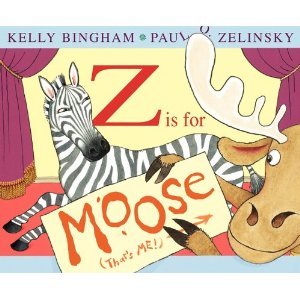 An ABC book with a excited and persistent Moose trying to get into the show and a Zebra trying to keep things in order. Moose tries for a feature with the Ice cream, Jar and Kangaroo – each time asking “Now?” The disappointment when M is reached- they decided to go with the mouse – is a great storytime moment. It leads to an angry moose, a controlling zebra, and finally a time of forgiveness. (Parallel to parenting, perhaps.) Cleverly done and very funny, especially as a read aloud where the kids will yell out where the moose has appeared or what he is doing now. A big standout in the world of ABC books.
An ABC book with a excited and persistent Moose trying to get into the show and a Zebra trying to keep things in order. Moose tries for a feature with the Ice cream, Jar and Kangaroo – each time asking “Now?” The disappointment when M is reached- they decided to go with the mouse – is a great storytime moment. It leads to an angry moose, a controlling zebra, and finally a time of forgiveness. (Parallel to parenting, perhaps.) Cleverly done and very funny, especially as a read aloud where the kids will yell out where the moose has appeared or what he is doing now. A big standout in the world of ABC books.
Bonus video!
Links to material on Amazon.com contained within this post may be affiliate links for the Amazon Associates program, for which this site may receive a referral fee.
View Next 25 Posts




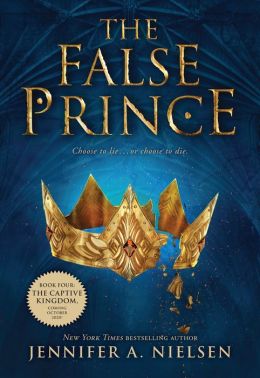

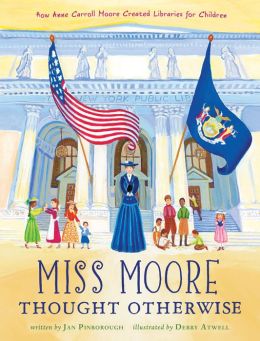

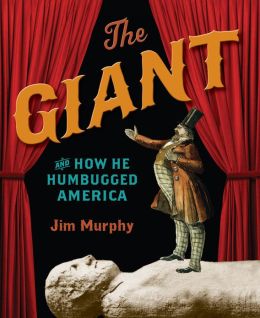



 First Book celebrated two big milestones this year – our 20th anniversary and
First Book celebrated two big milestones this year – our 20th anniversary and 












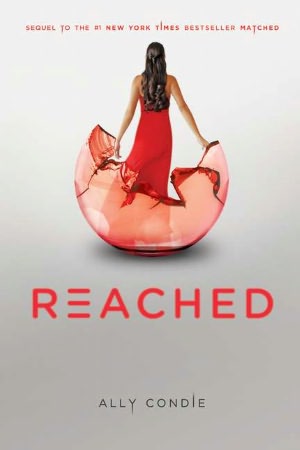
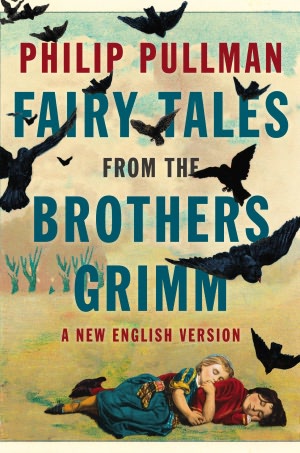
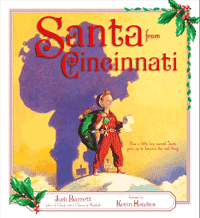



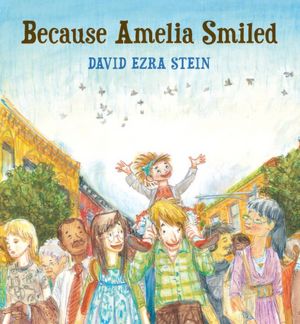
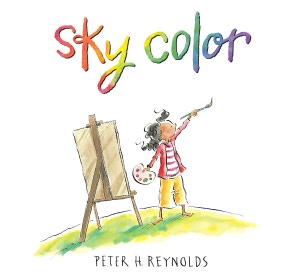
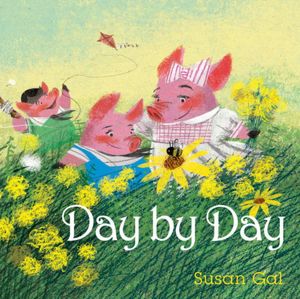
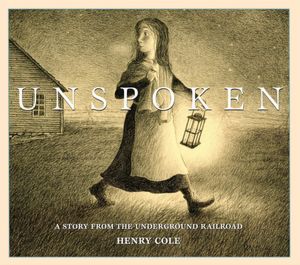













How can you not have read this one yet? I really enjoyed it too, though not as much as you did. Great review, and I loved the quote you picked out! :)
I loved the book as well and called it a fantasy when I began to write my review. What makes you call it a fantasy? Curious.
brenda (proseandkahn)
Did you know that Dark Triumph (Grave Mercy Book 2) is coming out soon? I'm reading it now, and it's amazing...
Also, (as I'm sure you know) The Runaway King (The False Prince Book 2) is out. I just got a review copy, and I can't wait!!